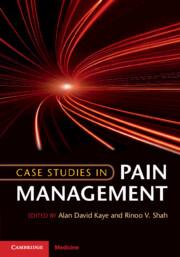18 results
Section 5 - Headaches and Facial Pain
-
- Book:
- Case Studies in Pain Management
- Published online:
- 05 October 2014
- Print publication:
- 16 October 2014, pp 297-340
-
- Chapter
- Export citation
Section 4 - Visceral Pain
-
- Book:
- Case Studies in Pain Management
- Published online:
- 05 October 2014
- Print publication:
- 16 October 2014, pp 253-296
-
- Chapter
- Export citation
Chapter 27 - Sacral insufficiency fracture and treatment options
- from Section 2 - Spinal Disorders
-
-
- Book:
- Case Studies in Pain Management
- Published online:
- 05 October 2014
- Print publication:
- 16 October 2014, pp 202-206
-
- Chapter
- Export citation
Case Studies in Pain Management - Title page
-
-
- Book:
- Case Studies in Pain Management
- Published online:
- 05 October 2014
- Print publication:
- 16 October 2014, pp iii-iii
-
- Chapter
- Export citation
Copyright page
-
- Book:
- Case Studies in Pain Management
- Published online:
- 05 October 2014
- Print publication:
- 16 October 2014, pp iv-iv
-
- Chapter
- Export citation
Case Studies in Pain Management - Half title page
-
- Book:
- Case Studies in Pain Management
- Published online:
- 05 October 2014
- Print publication:
- 16 October 2014, pp i-ii
-
- Chapter
- Export citation
Section 2 - Spinal Disorders
-
- Book:
- Case Studies in Pain Management
- Published online:
- 05 October 2014
- Print publication:
- 16 October 2014, pp 81-222
-
- Chapter
- Export citation
Section 6 - Cancer Pain
-
- Book:
- Case Studies in Pain Management
- Published online:
- 05 October 2014
- Print publication:
- 16 October 2014, pp 341-372
-
- Chapter
- Export citation
Section 1 - Neurological Disorders
-
- Book:
- Case Studies in Pain Management
- Published online:
- 05 October 2014
- Print publication:
- 16 October 2014, pp 1-80
-
- Chapter
- Export citation
Contributors
-
-
- Book:
- Case Studies in Pain Management
- Published online:
- 05 October 2014
- Print publication:
- 16 October 2014, pp xi-xv
-
- Chapter
- Export citation
Dedication
-
- Book:
- Case Studies in Pain Management
- Published online:
- 05 October 2014
- Print publication:
- 16 October 2014, pp v-vi
-
- Chapter
- Export citation
Index
-
- Book:
- Case Studies in Pain Management
- Published online:
- 05 October 2014
- Print publication:
- 16 October 2014, pp 508-529
-
- Chapter
- Export citation
Section 7 - Special Topics
-
- Book:
- Case Studies in Pain Management
- Published online:
- 05 October 2014
- Print publication:
- 16 October 2014, pp 373-507
-
- Chapter
- Export citation
Chapter 6 - Patient with post-thoracotomy pain
- from Section 1 - Neurological Disorders
-
-
- Book:
- Case Studies in Pain Management
- Published online:
- 05 October 2014
- Print publication:
- 16 October 2014, pp 43-45
-
- Chapter
- Export citation
Section 3 - Musculoskeletal Pain
-
- Book:
- Case Studies in Pain Management
- Published online:
- 05 October 2014
- Print publication:
- 16 October 2014, pp 223-252
-
- Chapter
- Export citation
Chapter 28 - Skeletal metastases and treatment options
- from Section 2 - Spinal Disorders
-
-
- Book:
- Case Studies in Pain Management
- Published online:
- 05 October 2014
- Print publication:
- 16 October 2014, pp 207-213
-
- Chapter
- Export citation
Contents
-
- Book:
- Case Studies in Pain Management
- Published online:
- 05 October 2014
- Print publication:
- 16 October 2014, pp vii-x
-
- Chapter
- Export citation

Case Studies in Pain Management
-
- Published online:
- 05 October 2014
- Print publication:
- 16 October 2014



